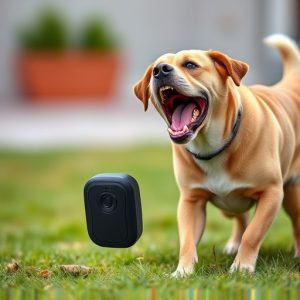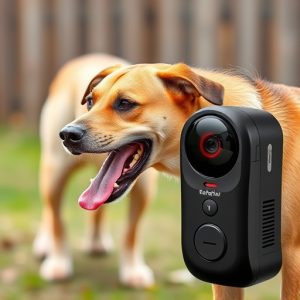Handheld Sonic Devices: Effective Pet Behavior Control for Dogs
Sound wave technology, specifically handheld sonic dog deterrents, offers a safe and effective solut…….
Sound wave technology, specifically handheld sonic dog deterrents, offers a safe and effective solution for pet behavior control. These devices emit high-frequency inaudible sounds that modify unwanted behaviors like barking or aggression without causing harm, leveraging dogs' sensitive hearing for natural aversion responses. Effectiveness varies based on breed, age, and temperament; consistent usage and proper training are crucial. Training involves gradual exposure to the sound, positive reinforcement for calm behavior, and following manufacturer guidelines to prevent harm. These deterrents are a humane alternative to traditional methods, popular among responsible pet owners and animal advocates.
“Unleash a new approach to pet behavior control with sound wave technology. This innovative method, specifically focusing on handheld sonic devices, offers a non-invasive solution for managing canine behavior. We explore how these devices work and their proven effectiveness in modifying pets’ reactions through controlled sound waves.
The article delves into the advantages, considerations, and safety guidelines surrounding this game-changing pet care tool, providing essential insights for responsible ownership.”
- Understanding Sound Wave Technology for Pet Behavior Modification
- Handheld Sonic Devices: How They Work and Their Effectiveness on Dogs
- Advantages and Considerations in Using Sonic Deterrents for Pets
- Training and Safety Guidelines for Sonic Dog Deterrents
Understanding Sound Wave Technology for Pet Behavior Modification
Sound wave technology has emerged as a novel approach to pet behavior control, offering a safe and humane alternative to traditional training methods. At its core, this technology leverages specific sound frequencies to influence an animal’s behavior. One prominent application is the Handheld Sonic Dog Deterrent, which uses high-frequency sound waves to modify unwanted behaviors in dogs without causing harm. The device emits sounds that are inaudible to humans but can be detected by canine ears, stimulating a natural aversion response.
The effectiveness of this technology lies in its ability to target specific behaviors while remaining non-invasive. Training sessions are often quicker and more efficient compared to traditional positive or negative reinforcement methods. Moreover, sound wave deterrents can be used in various settings, from homes to public spaces, making them a versatile tool for pet owners looking to manage their dog’s behavior effectively.
Handheld Sonic Devices: How They Work and Their Effectiveness on Dogs
Handheld sonic devices, designed as dog deterrents, utilize high-frequency sound waves to discourage unwanted behaviors in canines. These portable tools emit an ultrasonic frequency range, typically above 25 kHz, which is inaudible to humans but perceived as an annoyance by dogs. The principle behind their effectiveness lies in the sensitivity of a dog’s hearing; they can detect sounds far beyond human perception. When activated, these devices project sound waves that create a temporary discomfort or distraction for the dog, prompting them to modify their behavior.
Research on handheld sonic dog deterrents shows mixed results regarding their overall effectiveness. While some dogs may respond quickly to the high-pitched noise, others might not be affected due to varying levels of sensitivity or habituation. Factors such as breed, age, and individual temperament play a role in how dogs perceive and react to these sounds. Nonetheless, when used consistently and correctly, sonic deterrents can be a non-lethal, humane option for managing specific behaviors like barking or aggression, offering an alternative to traditional, potentially harmful methods.
Advantages and Considerations in Using Sonic Deterrents for Pets
The use of handheld sonic dog deterrents has gained popularity as a humane and effective solution for pet behavior management, especially in addressing unwanted actions like barking or aggression. These devices emit high-frequency sound waves that are unpleasant to dogs but generally harmless, encouraging them to alter their behavior. One significant advantage is their non-lethal nature, making them a preferred choice for responsible pet owners and animal advocates. They can be easily carried and used on the spot, providing immediate feedback to pets without causing any lasting harm.
However, considerations should be made regarding their effectiveness and potential drawbacks. While many devices claim success in modifying pet behavior, individual results may vary. Factors like the dog’s breed, size, sensitivity, and training play a role in how responsive they are to sonic deterrents. Additionally, consistent usage and proper training techniques are essential for long-term success. Some pets might become desensitized over time, requiring adjustments in frequency or sound intensity. Therefore, thorough research and understanding of both the technology and pet’s characteristics are crucial to ensuring positive outcomes when employing handheld sonic dog deterrents.
Training and Safety Guidelines for Sonic Dog Deterrents
Training and Safety Guidelines for Sonic Dog Deterrents
When it comes to using a handheld sonic dog deterrent, effectiveness hinges on proper training. Start by familiarizing your pet with the device’s unique sound. Play the deterrent at a low volume in controlled environments, gradually increasing the intensity as they become accustomed to the tone. Positive reinforcement is key; reward calm behavior during and after exposure to the sound. Consistency is crucial—regular practice sessions will help normalize the noise over time.
Safety is paramount when employing sonic deterrents. Always follow manufacturer guidelines regarding use and frequency of activation. Keep the device away from sensitive areas like your pet’s ears, as high-frequency sounds can cause discomfort or even damage. Supervise interactions to ensure the deterrent doesn’t inadvertently trigger fear or anxiety in your pet. Regularly review the product’s safety features and understand the limitations to ensure safe and effective training.
Handheld sonic devices, or sound wave pet behavior controls, offer a non-invasive and effective solution for modifying canine behavior. Their unique ability to emit specific frequencies targeting dogs’ sensitive hearing has proven successful in deterring unwanted actions like barking, jumping, or aggression. While these devices provide an innovative approach to training, it’s essential to follow safety guidelines and consider potential drawbacks. Responsible use of handheld sonic dog deterrents, combined with traditional training methods, can lead to positive behavioral changes in pets, enhancing the quality of life for both animals and their owners.


